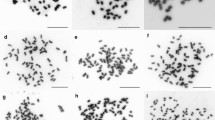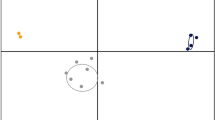Abstract
A total of 3 384 individuals of Scilla scilloides Druce were sampled from 40 natural populations at 35 different localities over the Korean Peninsula and analysed cytogenetically. The following cytogenetic types were found: AA (19.6%), AABB (72.4%), ABBB (4.3%), AABBB (3.0%) and aneuploids (0.8%). Of these, AA was found in 9 populations along the west side of the Korean Peninsula facing the Yellow Sea and on Yeongdo and Jeju Islands. Type AABB, the most common type in the complex, was found in 33 natural populations on the Korean Peninsula and Jeju Island. The distributions of ABBB and AABBB are restricted to the southern part of the Korean Peninsula and Jeju Island; they were found in 8 natural populations. In southern Korea the above four types showed overlapping distribution and two or three were often found growing together.
Genome A, occurring in the three allopolyploids in the Korean Peninsula, was the same as that in allopolyploids in Japan. However, genome A occurring as AA diploids was karyotypically different from that in the allopolyploids. On the basis of distribution patterns and cytological features, the origin of the allopolyploids is discussed.
Similar content being viewed by others
References
Araki, H., 1971. Cytogenetics of Scilla scilloides complex. III. Homoeology between genomes A (x=8) and B (x=9). Jpn. J. Genetics 46: 265–275.
Araki, H., 1972a. Cytogenetics of Scilla scilloides complex. IV. Eu- and aneuploid offspring from allotriploids in a natural population. Jpn. J. Genetics 47: 73–83.
Araki, H., 1972b. Cytogenetic study of Scilla scilloides complex from Korea. Jpn. J. Genetics 47: 147–150.
Araki, H., Hidaka, S. & Takahashi, S., 1976. Cytogenetics of the Scilla scilloides complex. VI. The structures of natural populations. Bot. Mag. Tokyo 89: 83–91.
Araki, H., 1977. Year-after-year occurrence of aneuploids in a natural population of the Scilla scilloides complex. Bull. Fukuoka Univ. Educ. 26(111): 77–83.
Darlington, C. D., 1964. Chromosome botany and the origins of cultivated plants. George Allen & Unwin, London.
Haga, T. & Noda, S., 1958. Cytogenetic population structure of Scilla scilloides Druce: a complex. Proc. Xth Intern. Congr. Genet. 2: 109.
Haga, T. & Noda, S., 1963. Population structure and dynamics in a complex Scilla scilloides (Liliaceae). Proc. XIth Intern. Congr. Genet. 1: 150.
Haga, T. & Noda, S., 1976. Cytogenetics of the Scilla scilloides complex. I. Karyotype, genome and population. Genetica 46: 161–176.
Ihara, M., 1977. Genecological census in natural populations of Scilla scilloides (Lindl.) Druce (Scilleae-Liliaceae). J. Fac. Sci. Univ. Tokyo III, 12: 65–137.
Maekawa, F., 1944. Prehistoric-naturalized plants to Japan proper. (Japanese). Acta Phytotax. Geobot. 13: 274–279.
Morinaga, T., 1932. A preliminary note on the karyological types of Scilla japonica Bak. Jpn. J. Genetics 7: 202–205.
Newcomer, E. H., 1953. A new cytological and histological fixing fluid. Science 118: 161.
Noda, S., 1974. Cytogenetics of Scilla scilloides complex. II. Evidence for homoeological relationship between the genomes. Cytologia 39: 777–782.
Noda, S., 1976. Outline of natural habitats and geographical distributions of Scilla scilloides in East Asia. Bull. Cult. Nat. Sci. Osaka Gakuin Univ. 2: 77–102.
Ohwi, J., 1965. Flora of Japan. Smithsonian Institution, Washington.
Okabe, S., 1938. Über den Karyotypus einer n = 9-chromosomigen Rasse von Scilla thunbergii Miyabe et Kudo. (Japanese). Botany Zool. 6: 481–483.
Satô, D., 1935. Chromosome studies in Scilla. I. Analysis of karyotypes in Scilla with special references to the origin of aneuploids. Bot. Mag. Tokyo 49: 298–305.
Satô, D., 1942. Karyotype alteration and phylogeny in Lillaceae and allied families. Jpn. J. Botany 12: 57–161.
Satô, D., 1953. Karyotype analysis and law of homologous series. Sci. Pap. Coll. gen. Educ. Univ. Tokyo 3: 41–53.
Sharma, A. K. & Sharma, A., 1972. Chromosome techniques. 2nd ed. Butterworths, London and Univ. Park Press, Baltimore.
Stebbins, G. L., 1971. Chromosomal evolution in higher plants. Edward Arnold, London.
Yamaguchi, T., 1959. The journey of the Lyeoris radiata Herb. to Japan as a relief plant in a rice lean year. (Japanese). Nat. Sci. Mus., Tokyo 26: 147–153.
Author information
Authors and Affiliations
Rights and permissions
About this article
Cite this article
Araki, H. The distribution of diploids and polyploids of the Scilla scilloides complex in Korea. Genetica 66, 3–10 (1985). https://doi.org/10.1007/BF00123600
Received:
Accepted:
Issue Date:
DOI: https://doi.org/10.1007/BF00123600




